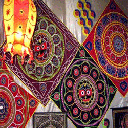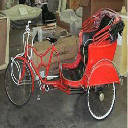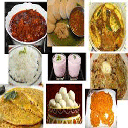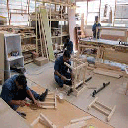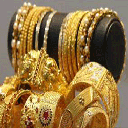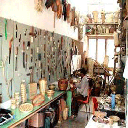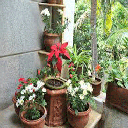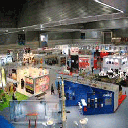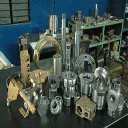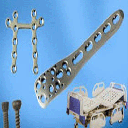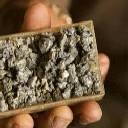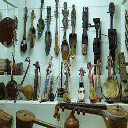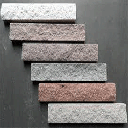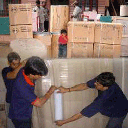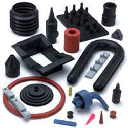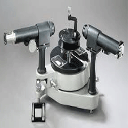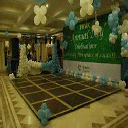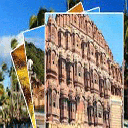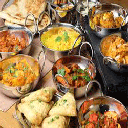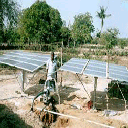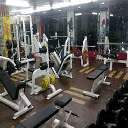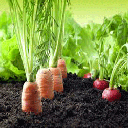Uttar Pradesh is India's fifth largest and most populous state, located in the north-central part of the country. It spreads over a large area, and the plains of the state are quite distinctly different from the high mountains in the north. The climate of Uttar Pradesh can also vary widely, with temperatures as high as 47 °C in summer, and as low as -1 °C in winter.Uttar Pradesh is bounded by Nepal on the North, Uttrakhand on the north-east, Himachal Pradesh on the north-west, Haryana on the west, Rajasthan on the south-west, Madhya Pradesh on the south and south-west, and Bihar on the east. Situated between 23°52'N and 31°28'N latitudes and 77°3' and 84°39'E longitudes, this is the fifth largest state in the country in terms of area, and the first in terms of population. Uttar Pradesh can be divided into three distinct hypsographical regions : The Himalayan region in the North - Highly rugged and varied terrain; transferred to Uttrakhand. Varying topography; elevation ranges from 300 to 5000m; slope ranges from 150 to 600 m/km. The Gangetic Plain in the centre - Highly fertile alluvial soils; flat topography broken by numerous ponds, lakes and rivers; slope 2 m/km The Vindhya Hills and plateau in the south - Hard rock Strata; varied topography of hills, plains, valleys and plateau; limited water availability. Forests constitute about 12.8% of the total geographical area of the state. The Himalayan region and the terai and bhabhar area in the Gangetic plain have most of the forests. The Vindhyan forests consists mostly of scrub. The districts of Jaunpur, Ghazipur and Ballia have no forest land, while 31 other district have less forest area. Western Uttar Pradesh is more advanced in terms of agriculture as compared to the other regions in the state. Majority of the state population depends upon farming activities. Wheat, rice, pulses, oil seeds and potatoes are the major agricultural products. Sugarcane is the most important cash crop throughout the state. Uttar Pradesh is one of the most important state in India so far as horticulture is concerned. Apples and mangoes are also produced in the state. Uttar Pradesh supports about 15% of India's total livestock population. Of its livestock in 1961, 15% were cattle, 21% buffaloes, 13% goats and 8% other livestock. Between 1951 and 1956 there was an overall increase of 14% in the livestock population. There are about 8,000 km² of water area, including lakes, tanks, rivers, canals and streams. The fishing area in the state is over 2,000 km² and there are more than 175 varieties of fish. UP has also witnessed rapid industrialization in the recent past, particularly after the launch of policies of economic liberalization in the country. As of March 1996, there were 1,661 medium and large industrial undertakings and 296,338 small industrial units employing 1.83 million persons. The per capita state domestic product was estimated at Rs 7,263 in 1997-98 and there has been visible decline in poverty in the state. Yet, nearly 40 percent of the total population lives below the poverty line. There are numerous types of minerals and many industries have came up based upon these minerals. There are a number of cement plants in Mirzapur in the Vindhya region, a bauxite-based aluminium plant in the Banda region and sonbhadra region and copper in Pithora Garh, Almora Chamoli and Tehri Garhwal. In the hilly regions of the state many non-metallic minerals are found which are used as industrial raw materials. Coal deposits are found in the Singrauli region. The state is poor in its mineral resources. The only considerable deposits are of limestone in Mirzapur, Dehra Dun and Almora districts. These are being extracted and are used largely in cement manufacture. Uttar Pradesh has booming electronics industries, especially in UP-Delhi-NCR and Lucknow-Kanpur Corridor. It produces almost all types of durables. Cottage industries, such as handloom and handicrafts, have traditionally provided livelihood to a large number of people in the .
Agra Radhaswami Samadhi:It is often called the Mecca of Radhaswami religion. The holy ashes of the founder of the religion have been preserved here. On the sprawling lawns here, is a beautiful marvel temple with beautiful carving of fruits, flowers, leaves and plants which have been reduced into stone true to nature, and are distinctive specimens of the plastic arts. Open Time : 9 A.M. to 5.30 P.M. Other Religious Places Kailash temple Mankameshwar temple Balkeshwar temple Prithvinath temple Rajeshwar temple Guru ka tal gurudwara Baptist Church Catholic Church Digambar Jain Mandir Taj Mahal:One of the Seven Wonders of the World, Taj Mahal, is India’s most fascinating and beautiful monument.The Taj Mahal was built by the Mughal Emperor Shah Jahan as the final resting place for his beloved queen, Mumtaz. The monument was completed in 1653 A.D. This perfectly symmetrical monument took 22 years (1630-1652) to complete. Approximately 20,000 workers, Masons and jewelers worked hard to build it. Built by the Persian architect, Ustad Isa, The Taj Mahal is situated on the banks of the Yamuna River. It can be observed like a Mirage from the Agra Fort from where Emperor Shah Jahan looked at it, for the last eight years of his life as a prisoner of his son Aurangzeb. It is a masterpiece of symmetry, which seems to be floating in the air from a distance. The verses of Holy Koran as inscribed on it and at the top of gate with 22 small domes signify the number of years the monument took to built. The Taj Mahal has been built on a Marvel Platform that stands above a standstone platform. The most elegant dome of the Taj is the one with a diameter of 60 feet and a height of 80 feet. Directly under this dome is the tomb of Mumtaz Mahal. Shah Jahan's tomb was irected next to the dome by his son Aurangzeb. Fantastic Inley works using semi-precious stones decorate and interiors. Open Time : 6 A.M. to 7.30 P.M. (Friday is closed) Agra Fort:The great Mughal Emperor Akbar commissioned the construction of the Agra Fort in 1565 A.D, although additions were made till the time of his grandson Shah Jahan. The forbidding exteriors of this fort hide an inner paradise. The fort is crescent shaped, flattened on the east with a long, nearly straight wall facing the river. It has a total perimeter of 2.4 km, and is ringed by double castellated ramparts of red sandstone punctuated at regular intervals by bastions. There are a number of exquisite buildings like the Moti Masjid-a white marvel mosque akin to a perfect pearl, Diwan-e-Am, Diwan-e-Khaas, Jehangir's Palace, Khaas Mahal, Shish Mahal and Musamman or Samman Burj-where Shahjahan was held captive in 1666 A.D. Open Time : Sunrise to Sunset. Agra Fort Sikandra:The mausoleum of Emperor Akbar represents his philosophy and secular outlook, combining the best of Hindu and Muslim architectures in a superlative region. Completed in 1613 A.D. by his son Jahangir, it is one of the well preserved monuments. This was also the last resting place of the Mughal Empror Akbar. Open Time : Sunrise to Sunset. Itmad-e-Daulah: is the tomb of Mirza Ghyas Beg, a persian who offered his services in Akbar’s Court. The tomb was designed by Emperor Jehangir's Queen, Noorjahan, for his father Mirza Ghyas Beg during 1622-1628 A.D. Open Time : Sun rise to Sunset. Fatehpur Sikri :was built by the Mughal Emperor Akbar during 1564 A.D.Mughal Emperor Akbar had no heir. He visited holy men to enlist their prayers for his son. When he visited Sheikh Salim Chishti who lived at the village of Sikri, the saint foretold the emperor that he would be blessed with a son. When his son was born, he constructed his capital city and named it Fatehpur Sikri. The beautiful marvel tomb of Sheikh Salim Chishti still attracts thousands who seek blessings of the revered saint. Other renowned places are Dewane-e-Am, Dewane-e-Khaas, Buland Darwaja, Panch Mahal, Jodha Bai Palace and Birbal Bhawan. Fatehpur Sikri is about 39 K.M. from Agra. Open Time : Sunrise to Sunset. Chinni Ka Roja : This was constructed by Afzal Khan, A high official in the court of Shah Jahan. Decorated by glazed tiles on the facade, the structure clearly depicts the Persian influence in architecture. Open : Sunrise to Sunset Mariyam's Tomb : Emperor Akbar built this in the memory of his Goan Christian wife Mariyam. This unique tomb in red sandstone was built in 1611 A.D. The tomb has some exceptional carvings. Open : Sunrise to Sunset Jama Masjid : This building, with a rectangular open forecourt was constructed in 1648 A.D, by Shah Jahan's daughter, Jehanera Begum in memory of the famous Shiekh Salim Chistti and his grand son Islam Khan. It is wonderful assimilation of Iranian architecture. Allahabad Sangam:Around 7 km from Civil Lines, overlooked by the eastern ramparts of the fort, wide flood plains and muddy banks protrude towards the sacred Sangam. At the point at which the brown Ganges meets the Greenish Yamuna, pandas (priests) perch on small platforms to perform puja and assist the devout in their ritual ablutions in the shallow waters. Beaches and ghats are littered with the shorn hair of pilgrims who come to offer pind for their deceased parents. The sacred Sangam is the confluence of three of the holiest rivers in the Hindu mythology – Ganga, Yamuna and the mythical Saraswati. At the Sangam, the waters of the Ganges and the Yamuna can be distinctly seen merging into one. It is during the Kumbh / Ardh Kumbh that the Sangam truly comes alive, attracting the devout from all across the country. The holy Sangam is the site for Annual Magha Mela/Ardh Kumbh/Kumbh Mela. Boats are available for visitors. Kumbh Mela:Hindus traditionally regard river confluences as auspicious places, so the Sangam at Allahabad, where the Yamuna and the Ganges meet the River of Enlightenment, the mythical Saraswati is considered at the most auspicious place for the Hindus. According to a legend, Vishnu was carrying a kumbh (pot) of amrita (nectar), when a scuffle broke out between the gods, and four drops were spilled. They fell to earth at the four tirthas of Prayag, Haridwar, Nasik and Ujjain (tirtha means "ford of a river". Sangam is a place where the devout can cross from this finite world into divine celestial realms. The event is commemorated every three years by the Kumbh Mela, held at each tirtha in turn; the Sangam is known as Tirtharaja, the "King of Tirthas", and its Mela, once every twelve years, is the greatest and holiest of all. Patalpuri Temple: is an underground temple, inside the Allahabad fort. In this temple lies the Akshaya Vat – or the immortal tree. It is believed that Lord Rama, has visited the temple and the temple was also seen by the famous Chinese traveller and writer Hiuen Tsang during his visit to this place. Akshaya Vat:The immortal tree within the Patalauri temple, has found mention in the description of several ancient scriptures, writers and historians. The tree stands in a deep niche above an underground shaft, which is said to lead to Triveni. The Hanuman Mandir: near Sangam is unique in North India, for its supine image of Hanumana. The big idol of Lord Hanumana is in a reclining posture. When the Ganga is in spate, this temple gets submerged. Shankar Viman Mandapam :is 130 feet high with four floors, it has the idols of Kumaril Bhatt, Jagatguru Shankaracharya, Kamakshi Devi (with 51 Shaktipeethas around), Yogsahastra Sahastrayoga Linga (with 108 Shivas around). Mankameshwar temple: is situated near Saraswati Ghat, on the banks of Yamuna, this is one of the famous Shiva Temples of Allahabad. Allahabad Fort:The massive fort built by Emperor Akbar in 1583 A.D., the fort stands on the banks of the Yamuna near the confluence site. In its prime, the fort was unrivalled for its design, construction and craftsmanship. This huge, majestic fort has three magnificent galleries flanked by high towers. At present is used by the army and only a limited area is open for visitors. The magnificent outer wall is intact and rises above the water edge. Visitors are allowed to see the Ashokan Pillar and Saraswati Kup, a well, said to be the source of the Saraswati River and Jodhabai Palace. The Patalpur temple is also here. So is the much revered Akshaya Vat or immortal Banyan tree. Ashoka Pillar:This gigantic Ashoka pillar, of polished sandstone stands 10.6 meters high and dates back to 232 B.C. The pillar has several edicts and a Persian inscription of Emperor Jahangir in scripted on it, commemorating his accession to the throne. Minto Park: is situated near Saraswati Ghat, it has a stone memorial with a four-lion symbol on top, the foundation of which was laid by Lord Minto in 1910. Ayodhya The Hanuman Garhi temple: is situated in the centre of the town. One has to cover the 76 steps which are the way to reach the temple. Legends say that Hanuman lived here in a cave and guarded the Janambhoomi or Ramkot. The main temple contains the statue of Maa Anjani, with Bal Hanuman seated on her lap. The faithful believe that all their wishes are granted with a visit to this holy shrine. This is the most popular shrine in Ayodhya. Kanak Bhawan :has images of Sri Rama and Sita wearing gold crowns. It is also known as Sone-ke-Ghar. Ramkot: the janambhoomi of Lord Rama is the chief place of worship in Ayodhya. The place is visited by pilgrims throughout the year, from all over India and abroad. `Ram Navami’, the day of Lord’s birth, is celebrated with great pomp and show, in the Hindu month of Chaitra (March-April). Swarg Dwar: according to mythology, is the place where Lord Rama have been cremated. Treta ke Thakur:is a temple which stands at the place where Lord Rama is said to have performed the Ashvamedha Yagna. About 300 years ago the Raja of kulu built a new temple here, which was improved by Ahalyabai Hokar of Indore during 1784, at the same time the adjoining Ghats were also built. The initial idols in black sandstone were recovered from Saryu and placed in the new temple, famous as Kaleram-ka-Mandir. The temple of Nageshwarnath Temple: is said to have been established by Kush the son of Rama. Legend has it that Kush lost his armlet, while bathing in the Saryu, which was picked up by a Nag-Kanya, who fell in love with him. As she was a devotee of Shiva, Kush erected this temple for her. It is said that this has been the only temple to have survived till the time of Vikramaditya, the rest of city had fallen into ruins and was covered by dense forests. It was by means of this temple that Vikramaditya was able to locate Ayodhya and the sites of different shrines here. The festival of Shivratri is celebrated here with great pomp and splendor. Rishabhadeo Jain Temple:Brahma Kund, Amawan Temple, Tulsi Chaura, Laxman Quila, Angad Tila, Shri Rama Janaki Birla Temple, Tulsi Smarak Bhawan, Ram ki Paidi, Kaleramji ka Mandir, Datuvan Kund, Janki Mahal, Gurudwara Brahma Kund, Ram Katha Museum, Valmiki Ramayan Bhawan, are among other places of interest in Ayodhya. Bithoor The Valmiki Ashram: is located at a height and it is accessible by a flight of stairs which are known as the "stairway to heaven". A panoramic view of Bithoor can be enjoyed from this ashram. Brahmavart Ghat: is considered the holiest Ghat of Bithoor. Devotees of Lord Brahma pray at the altar of the "Wooden Slippers" after a ritual dip in the Ganga. Dhruva teela: marks the place where the child Dhruva meditated single mindedly as he stood on one leg. As a reward, God granted Dhruva the divine boon to shine for all time as a star. Ram Janki temple, Luv-Kush temple, Haridham Ashram and NanaRao Smarak. Braj Bhoomi Mathura The birth place of Lord Krishna, "the best known, best loved and most complex of Lord Vishnu's manifestations" - Mathura is today an important place of pilgrimage. The city is situated on the right bank of the Yamuna River and the continuous line of ghats along the river makes a splendid spectacle when viewed from the opposite bank. Today, Mathura is a city of temples and shrines abustle with the thousands of devotees who come to visit the city of Lord Krishna. Katra Keshav Dev : A splendid temple at the Katra Keshav Dev marks the spot that is believed to be the Shri Krishna Janmasthan - the birthplace of the Lord, by his devotees. Gita Mandir : The Gita Mandir, located on the Mathura -Vrindavan Road has a fine image of Shri Krishna in its sanctum. The whole of the Bhagwad Gita is inscribed on the walls of this temple. Dwarikadhish Temple : The most popular shrine at Mathura is the Dwarikadhish Temple to the north of the town, dedicated to Shri Krishna. This was built in 1815 by a staunch and wealthy devotee, Seth Gokuldas Parikh, Treasurer of the State of Gwalior. Ghats : There are about 25 ghats in Mathura today, of which the most important is the Vishram Ghat. Where according to legend, Shri Krishna took his rest after killing Kansa. It is at Vishram Ghat that the traditional parikrama (circumbulation of all the important religious and cultural places of the city) starts and ends. The 12 ghats to the north of Vishram Ghat include the Ganesh Ghat, Dashashwamedh Ghat with its Neelakantheshwar Temple, Saraswati Sangam Ghat, Chakratirtha Ghat, Krishnaganga Ghat, Somatirth or Swami Ghat, Ghantagharan Ghat, Dharapattan Ghat, Vaikuntha Ghat, Navtirtha or Varahkshetra Ghat, Asikunda ghat and Manikarnika Ghat. To the south, there are 11 ghats - the Guptatirth Ghat, Prayag Ghat marked by the Veni Madhav Temple, Shyam Ghat, Ram Ghat, Kankhal Ghat, the site of the Janmashtami and Jhula festivals, Dhruva ghat, Saptrishi Ghat, Mokshatirth Ghat, Surya Ghat, Ravan Koti Ghat and Buddha Ghat. The Vishram Ghat is lined with elegant temples and some of Mathura's most important shrines are found here - the Mukut Temple, Radha-Damodar, Murli Manohar, Neelkantheshwar, Yamuna-Krishna, Langali Hanuman and Narasimha temples. The baithak of the great Vaishnava Saint, Shri Chaitanya, is also near by. The aarti held at the Vishram Ghat each evening is not to be missed, for the little oil lamps that are floated on the river set the placid water as sparkle with myriad flickering lights. No pilgrimage to Mathura is complete without a visit to its kunds. Tradition has it that there were 159 ancient kunds in all. Of these only four survive and can be seen. There is the elegant shiv Tal, the more famous Potara Kund associated closely with Lord Krishna besides the Balbhadra and Saraswati kunds. Sati Burj : Sati Burj, 17 mt. high, built of red sandstone in 1570 AD, is a slim tower which commemorates the death of a noble lady - widow of Raja Bihari Mal of Amer who committed sati. The four storeyed towers was erected by Raja Bhagwan Das on the right bank of the Yamuna at Sati Ghat Jama Masjid : The Jama Masjid with its four lofty minarets and bright mosaic, built in 1661 AD, is also a must see. Government Museum : The Government Museum, Mathura originally founded by F.S. Growse in 1874, is today one of the leading centres for research, study and the preservation of Mathura' s splendid heritage of art. The museum housed in a fine octagonal, red sandstone building, located at Dampier Park, has the largest collection of Kushana sculptures in the country. The Museum has also fine collections of stone sculpture and terracotta, gold, silver and copper coins, clay seals, ancient pottery, paintings and bronzes. Braj Parikrama:The Rainy month of Bhadon, the month when the Lord Krishna was born, is a time of colourful celebrations. The famous Braj Parikrama - a pilgrimage of all the places in Braj that associated with Shri Krishna, is undertaken. Traditionally, the Chaurasi kos (84 kos) pilgrimage of Braj Mandal, with its 12 vanas (forests). 24 upvanas (groves), sacred hill Govardhan, divine River Yamuna and numerous holy places along its banks, is undertaken annually by lakhs of devotees from all over the country. The Yatra extends to Kotban to the north of Mathura, to Nandgaon, Barsana and the Govardhan Hill to the west and South-west of the city and to the banks of the Yamuna to the east, where the Baldeo Temple is located. Gokul:The most celebrated of Shri Krishna's abode, Gokul lies to the west of Sadabad, 1.6 km from Mahavan and 15 km south-east of Mathura, on the Mathura - Etah metalled road. It was here that Lord Krishna was brought up in secrecy by Yashoda, in the pastoral beauty of this village on the banks of the Yamuna. Gokul attained importance during the time of Vallabhacharya (1479-1531) when it became a major centre of the Bhakti cult. The three oldest temples in the place are those dedicated to Gokulnath, Madan Mohan and Vitthalnath, said to have been built around 1511. The other temples include those of Dwarika Nath and Balkrishna in the shrines which were built in the honour of Lord Mahadeo in 1602 by Raja Vijai Singh of Jodhpur. Important sites worth visiting in Gokul include the Gokulnath Temple, Raja Thakur Temple, Gopal Lalji Temple and the Morwala Temple. Mahavan:Around 18 km from Mathura, lying on the left bank of the River Yamuna, is the large shrine of Mathuranath. It is famed for its Chaurasi Khambha (eighty four pillars). The palace of Rohini, the mother of Baldeo is now the Chhathi-Palana Temple. Other important shrines include the Shymlalji Temple, the Yogmaya Temple, Tranairatri Temple and the Mahamall Rai Ji's palace. Baldeo: is 20 km south-east of Mathura and 8.5 km south - east of Mahavan on the road to Sadabad. It derives its name from the famous temple dedicated to Balram, the elder brother of Lord Krishna. It was built by Shyam Das of Delhi 200 years ago. The main image in the sanctum is that the Baldeo or Balram with his spouse Revati. Near by is the brick lined tank, the Khir Sagar or Balbhadra Kund, from where the original image housed in the temple was found. Govardhan: is situated 26 km west of Mathura on the state highway to Deeg. A famous place of Hindu pilgrimage, Govardhan is located on a narrow sandstone hill known as Giriraj which is about 8 km in length. The young Lord Krishna is said to have held Giriraj up on the tip of a finger for 7 days and nights to shield the people of Braj from the deluge of rain sent down by Lord Indra. Govardhan is set along the edge of a large masonry tank known as the Mansi Ganga, which is believed to have been brought into existence by the operation of the divine will. Barsana: 50 km to the north-west of Mathura and 19 km north-west of Govardhan, is situated at the foot of a hill that is named after Brahma. Barsana was once the home of Radha-Rani, Krishna's beloved and consort. Temples dedicated to the divine couple ornament the four elevations of the hill. The main among them is the Radha-Rani Temple, more fondly referred to as the Ladliji Temple. The most beautiful temple at Barsana, it was built by Raja Bir Singh Ju Deo of Orchha in 1675. The new marble temple adjoining it is a later addition. The other three shrines are the Man Mandir, Dargah and Mor-Kutir temples. The area between the hill housing the Radha-Rani Temple and the adjoining one, is known as the Sankari-Khor. This is the venue of the annual fair held in the month of Bhadon (July-August). Barsana is also famous for its 'Latthmar' Holi-celebration of the festival of colour that is unique to this town. Nadgaon :lies 8.5 km north of Barsana on the metalled road to Mathura (56 km). According to tradition, it was the home of Shri Krishna's foster father, Nand. On the top of the hill is the spacious temple of Nand Rai, built by the Jat ruler Roop Singh. The other temples here are dedicated to Narsingha, Gophinath, Nritya Gopal, Girdhari, Nand Nandan and Yashoda Nandan which is located half way up the hill. A little beyond is the Pan Sarovar, a large lake with masonry ghats along its sides. Legend has it, that this was the place where Shri Krishna used to take his cows for water. Not far away is the Kadamb grove called Udhoji - Ka- Kyar. Radhakund:Just 5 km north of Govardhan and 26 km west of Mathura, Radhakund is a large lake, where Shri Krishna is said to have killed Arista - the bull demon. To commemorate this event, every year on the 8th day of the dark half of the month of Kartik (Oct./Nov.), a large fair is held here. Vrindavan:just 15 km from Mathura, is another major place of pilgrimage. It is noted for its numerous temples - both old and modern. The name Vrindavan evokes the playfulness and lovable characteristics of Shri Krishna. This is the wood where he frolicked with the gopis and tenderly wooed Radha. Vrindavan today, is noted for its numerous temples. The most important are : Madan Mohan Temple : The Madan Mohan Temple located near the Kali Ghat which was built by Kapur Ram Das of Multan. This is the oldest existent temple in Vrindavan today. The temple is closely associated with the saint Chaitanya. The original idol of Lord Madan Gopal was shifted from the shrine to Karauli in Rajasthan for safe keeping, during Aurangzeb's rule. Today, replica of the image is worshipped at the temple. Banke Bihari Temple : The Banke Bihari Temple built in 1864 is the most popular shrine at Vrindavan. The image of Banke Bihari was discovered in Nidhi Vana by Swami Haridas Ji, the great Krishna devotee, belonging to the Nimbarka sect. Radha Vallab Temple : The famous Radha Vallab Temple set up by the Radha-Vallab sect has the crown of Radha-Rani placed next to the Shri Krishna idol in the sanctum. Jaipur Temple : The Jaipur Temple which was built by Sawai Madhav Singh, the Maharaja of Jaipur in 1917, is a richly embellished and opulent temple. The fine hand - carved sandstone is of unparalleled workmanship. The temple is dedicated to Shri Radha-Madhav. Shahji Temple : The Shahji Temple, another popular temple at Vrindavan, was designed and built in 1876 by a wealthy jeweller, Shah Kundan Lal of Lucknow. The deities at the temple are popularly known as the Chhote Radha Raman. Rangaji Temple : The Rangaji Temple, built in 1851, is dedicated to Lord Ranganatha or Rangaji depicted as Lord Vishnu in his Sheshashayi pose, resting on the coils of the sacred Shesha-nag. The temple built in the Dravidian style has a tall gopuram (gateway) of six storeys and gold plated Dhwaja Stambha, 50 feet high. A water tank and a picturesque garden lie within the temple enclosure. The annual festival of Jal Vihar of the presiding deity is performed with great pomp and splendour at the tank. The temple is also famous for its 'Brahmotsav' celebration in March-April, more popularly known as the 'Rath ka Mela'. The ten day long celebrations are marked by the pulling of the rath (the chariot car) by the devotees from the temple to the adjoining gardens. Govind Deo Temple : The Govind Deo Temple was once a magnificent seven storeyed structure built in the form of a Greek cross. It is said that the Emperor Akbar donated some of the red sandstone that had been brought for the Red Fort at Agra, for the construction of this temple. Built at the astronomical cost of one Crore rupees in 1590 by his general Man Singh, the temple combines western, Hindu and Muslim architectural elements in its structure. Shri Krishna-Balram Temple : The Shri Krishna-Balram Temple built by the International Society for Shri Krishna Consciousness (ISKCON), is one the most beautiful temples in Vrindavan today. The principal deities of this temple are Shri Krishna - Balram and Shri Radha - Shyam Sundar. Adjoining the temple is the samadhi of Shri Prabhupada, the founder of the ISKCON sect, built in pure white marble. Other places of interest include the Sriji Temple, Jugal Kishore Temple, Kesi Ghat, Lal Babu Temple, Raj Ghat, Meera Bai Temple, Imli Tal, Kaliya Ghat, Raman Reti, Varah Ghat and Chir Ghat. Vrindavan is connected to Mathura and all other places of Braj by rail and bus services. Chitrakoot Kamadgiri: is a forested hill of prime religious significance; this is believed to be the original Chitrakoot. The Bharat Milap Temple is located here. Pilgrims perform a ritual to seek blessings. Sphatik Shila: is a picturesque spot marked by two immense rocks. It is believed to be the place where Lord Rama and Sita feasted their eyes on the beauty of Chitrakoot. Hanuman Dhara: is located on a steep hillside; it is approachable by a flight of 360 steps. Here, the waters of a natural spring cascade over an image of Lord Hanuman. Ram Ghat:is on the banks of the River Mandakini, and it is the centre of ritual activity. This ghat is the most frequented in Chitrakoot. The "Aarti" performed in the evening is particularly beautiful. Janki kund: is an unusual cave over the Mandakini. Said to be the place where Sita bathed. Deogarh Dashavatar temple: was built by Gupta’s. This temple is dedicated to Lord Vishnu and was earlier known as Panchyatan temple in North India. The terraced basement above the high plinth is decorated with sculpted panels. The figures of Ganga and Yamuna adorn the carved doorway leading to the sanctum sanctorum. Three large carved panels along the side walls-the Gajendramoksha panel, the Nar Narayan Tapasya and the Anantshayi Vishnu-depict scenes from Vaishnava mythology. Only the lower portion remains of the spire, which was the most important part of the temple. The jain temples: are situated inside the fort of Kanali on the hills overlooking the Betwa and are 31 in number. This place was a Jain centre from the 6th to the 17th century. The temples flourish in panels depicting scenes from Jain mythology, Tirthankara images, votive pillars, votive tablets, Jain images visible from all sides and pillars carved with a thousand Jain figures. Deogarh Archaeological Museum:The site museum has a fine collection of sculpture, discovered from the surrounding. Jaunpur Atala Masjid :was started in 1377 but completed only in 1408 in the reign of Ibrahim Sharquie. This mosque represents the earliest and finest example of Sharquie architecture, and conforms to the general plan of the orthodox mosque. Its most distinguishing feature is the original treatment of the facade of its prayer-hall composed of three large ornamental archways, the central one of which soaring to 23 mts, is gigantic. Jami Masjid :is the last great mosque of Jaunpur and also it’s largest. The Jami Masjid was built by Hussain Shah in 1458-78. In plan and design it is a larger version of the Atala Mosque. The imposing structure, raised on a high platform, encloses a courtyard of 66 mtr by 64.5 mtr. The interior of the prayer hall is topped by a lofty dome. Lal Darwaza Masjid:The construction of Lal Darwaza Masjid, said to have taken place around 1450, is attributed to Bibi Raji, the queen of Sultan Mahmud Shah. It is built on a much smaller area than the Atala Masjid. Khalis Mukhlis Masjid: was constructed by Malik Mukhlis and Khalis in 1417. Shahi Bridge: was constructed by Munim Khan in 1568 this picturesque old bridge spans the Gomti river. Shitla Choukiya Dham: is the famous, ancient temple of Jaunpur and is dedicated to Shitla Mata. Yamdagni Ashram :is a religious centre; this ashram is closely associated with the life of sage Parashuram. Other places of interest include Shahi Qil, Khwab-gah, Dargah Chishti, Pan-e-Sharif, Jahangiri Masjid, Akbari Bridge and the tombs of the Sharquie Sultans. Jhansi Jhansi Fort: was constructed in the 17th century fort and was made by Raja Bir Singh on top of a hill as an army stronghold. The Karak Bijli tank is within the fort. There is also a museum which has a collectiion of sculpture and provides an insight into the history of Bundelkhand. The Government Museum of Jhansi :has the weapons, statues, dresses and photographs that represent the Chandela dynasty and a picture gallery of the Gupta period are the highlights. There are also terracottas, bronzes, manuscripts, paintings and coins. Rani Mahal :the palace of Rani Laxmi Bai has now been converted into a museum. It houses a collection of archaeological remains of the period between 9th and 12th centuries AD. Laxmi Tal, Gangadhar Rao-Ki-Chhatri, Shri Kali Temple, Laxmi Bai Park. Kalinjar Neelkanth Temple :was built by the Chandela ruler Parmardi dev. In a position by the rock-cut Swagger Roan pool, stands a massive 18-armed image of Al Bhairav, the fearsome aspect of Lord Shiva. Vankhandeshwar Mahadev Temple: is located at the source of the Shivasari Ganga, this temple is also worth a visit. Kalinjar Fort: is situated at a height of 700 ft. on the Vindhya ranges, this fort is accessible through seven gateways-the Alamgir Darwaza, Ganesh Dwar, Chauburji Darwaza, Buddha Bhadra Darwaza, Hanuman Dwar, Lal Darwaza and Bara Darwaza. Within the fort are two palaces-the Raja Mahal and the Rani Mahal. The other places of interest in the fort are Sita Sej, a small cave containing a stone bed and pillow once used by hermits; a reservoir known as Patal Ganga; Pandu-Kund, where water trickles from the horizontal crevices of stratified rocks; Buddha-Budhi taal, whose waters are believed to possess healing qualities; Bhairon-ki-Jharia or Manduk Bhairon; the Mrigdhara or Antelope’s spring situated within an inner chamber of the rampart, and Koito Birth, which is an important place of pilgrimage where lepers are believed to be cured. Kanpur Jajmau:known as Siddhapuri in ancient times, is supposed to have been the kingdom of Yayati, the Pauranic king and the high mound overhanging the Ganga is known as the site of his fort. The mound of Jajmau, on the eastern end of the city occupies a high place among ancient cities of the region. Excavations of the mound were undertaken during 1957-58 which unearthed antiquities ranging from 600 BC to 1600 AD. Today, Jajmau houses the Siddhnath and Siddha Devi temples and the mausoleum of Makhdum Shah Ala-ul-Haq, the famous Sufi saint, built by Firoz Shah Tughlaq in 1358. A mosque built by Kulich Khan in 1679 also stands here. Shri Radhakrishna Temple: is famously known as J.K. Temple in Kanpur.Beautifully constructed, J.K. temple is a boon to the devotees. Built by J.K. Trust this architectural delight is a unique blend of ancient architecture with the modern. Among the five shrines that the temple has the central one is consecrated to Shri Radhakrishna and the other are adorned with idols of Shri Laxminarayan, Shri. Ardhanarishwar, Shri Narmadeshwar and Shri Hanumana. Jain Glass Temple: is situated in Maheshwari Mohal behind the Kamla Tower. It is a beautiful temple highly decorated with glass and enamel work. The Kanpur Memorial Church (All Soul’s Cathedral):The Kanpur Memorial Church was built in 1875, in honor of the British who lost their lives in the war of 1857. The Church was designed by Walter Granville, architect of the east Bengal Railway. The complete Church in Lombardic gothic style is handsomely executed in bright red brick, with polychrome dressings. The interior contains monuments to the mutiny, including several memorial tablets. Phool Bagh: is a beautiful park in the heart of the city on the Mall Road. In the centre of the park is a building known as Ganesh Shankar Vidyarthi Memorial. After the first World War there was an Orthopedic Rehabilitation Hospital in this building. It is now known as Ganesh Udyan. The Nana Rao Park: is located at the west of Phool Bagh. It is the site of the 'Bibighar’ of 1857. The Park was renamed as Nana Rao Park after independence. The Allen Forest Zoo or the Kanpur Zoo :was opened in 1971 and is ranked among one of the best zoos in the country. It is an ideal place for outdoor life and picnics amongst picturesque surroundings. Kamla Retreat: lies to the west of the Agricultural College in immediate neighborhood of the Allen Forest. It is under the possession of Singhania family and is a beauty spot of the city. There is a swimming tank with equipment for producing artificial waves and suitable arrangement for lighting. Besides parks and a canal with facilities for boating, a zoo is also maintained. Kamla Retreat also houses a museum which has a good collection of historical and archaeological artifacts. Important Educational Institutes Harcourt Butler Technological Institute : The Harcourt Butler Technological Institute was established in 1920 at Kanpur and is engaged in imparting technical training and industrial research. Indian Institute of Technology : The Indian Institute of Technology at Kanpur was set up in 1959. It provides education in the fields of engineering, technology, science and humanities. Chandra Shekhar Azad University of Agriculture & Technology : Chandra Shekhar Azad University of Agriculture & Technology was established in 1957 to provide education of agriculture, animal husbandry and veterinary science for the benefit of rural people. Among other sites worth visiting at Kanpur are the Hanuman temple-Panki, Anandeshwar temple, Jageshwar temple, Dwarikadhish temple, Prayagnarayan temple, Kailash temple, Buddhadevi temple, Kherepati temple, Varahidevi temple, Bhairav temple and Tulsi Upvan (Moti Jheel). Kapilvastu Stupa complex:is the main archaeological site which was discovered during excavations in 1973-74. The seals and inscriptions over the lid of the pot discovered read "Om Deoputra Vihare Kapilvastu Bhikschu Mahasanghasa" and "Om Deoputra Vihare Kapilvastu Bhikschu Sanghasa". The title Deoputra refers to Kanishka, a great patron of Buddhism who built the biggest Vihara at Kapilvastu and renovated the main stupa here. Palace Site :is a place where the ruins of the palace of King Shuddhodhan, father of Prince Gautam (Lord Buddha) are excavated by Dr. K.M. Srivastava. It is said that Lord Buddha has spent his first 29 years of life at this palace. Kushinagar Nirvana Stupa :is a huge brickwork stupa, exposed by Carlyl in 1876, which stands at a height of 2.74 mtr. A copper vessel was unearthed at this site. It bore an inscription in ancient Brahmi, which stated that Lord Buddha's remains had been deposited here. Nirvana temple: houses over 6 mtrs long statue of reclining Buddha. The image was unearthed during the excavations of 1876. Carved from Chunar sandstone, the statue represents the dying Buddha reclining on his right side. An inscription below dates the statue to the fifth century AD. Mathakuar shrine: lies about 400 yards from the Parinirvana stupa. A black stone image of the Buddha in the bhumi sparsha mudra was recovered here. The last sermon by Lord Buddha was given here. Ramabhar Stupa: is a large stupa which rises to a height of 49 ft. It marks the site where the Lord Buddha was cremated. In ancient Buddhist texts this stupa has been referred to as Mukut-Bandhan Vihar. Chinese Temple:is famous for its beautiful statue of Lord Buddha. Japanese Temple :has the beautiful Ashta Dhatu (eight metals) statue of Lord Buddha. This statue was bought from Japan. The Kushinagar Museum is also known as the Buddha Museum. Other places of interest include Pawanagar (Fazilnagar) and the Sun Temple at Turkpatti. Lucknow Chhota Imambara Hussainabad Imambara :is also called Chhota Imambara.Hussainabad Imambara is located near the Rumi Darwaza. It was built between 1837 and 1842 and that’s why it is famous as Chhota Imambara. This structure contains the tombs of Muhammad Ali Shah, its builder, and of his mother. It is approached through a fine garden. The Imambara has a white dome and numerous turrets and minarets. Shah Najaf Imambara :is a white-domed structure and it derived its name from the town of Najaf. The place is about 200km south of Baghdad where the saint Hazrat Ali is buried. The Shah Najaf Imambara is situated on the right bank of the Gomti. In this tomb are buried the remains of Ghazi-ud-din Haider and his wives, including Mubarak Mahal, his European wife. The entrance leads to a beautiful garden. The silver tomb of Ghazi-ud-din Haider lies in the centre of the building and is flanked by the more imposing silver and gold tomb of Mubarak Mahal on both the sides. Dudhwa National Park:Dudhwa is at a distance of 220km from Lucknow. The Dudhwa National Park is located close to the border with Nepal. The National Park covers an area of 490 sq km. The National park is also recognized as a Tiger Reserve. Mahoba Kakramath temple: is a well-preserved granite temple dedicated to Lord Shiva. The temple is located at the Madan Sagar. The temple’s basic plan is similar to the temples of Khajuraho. The Madan Temple dedicated to Lord Vishnu stands nearby. Vijay Sagar Pakshi Vihar :is a bird sanctuary which is a distance of 5 km from town. The bird sanctuary has been developed on the shores of Vijay-Sagar, built by Vijay Pal Chandela (1035-1060 AD). Sun Temple at Rahila Sagar:The Sun Temple lies to the west of Rahila Sagar, in the 9th century with granite rock.The temple is, built by Chandela ruler Rahila who ruled between 890 and 910 Ad. Manaiya Devi Temple :is the temple of the tutelary deity of the Chandelas and stands on the shores of Madan Sagar, near the fort. In front of it is monolithic granite, pillar, 18 ft. high and 1.75 ft wide at the base. The shrine of Pir Mubarak Shah, a Muslim saint who came from Arabia in 1252 AD, is nearby. Kirat Sagar: built by Kirtivarman between 1060 AD and 1100 AD, has fine embankments with granite steps. Madan Sagar, built by Madan Verma between 1128 AD and 1165 AD, is very picturesque. Other lakes include Kalyan Sagar, Vijay Sagar and Rahila Sagar. Gokhar hill: is the hill where Guru Gorakhnath resided with his disciples. It has dramatic granite rock formations, with caves and waterfalls. The spot is ideal for climbing and picnics. Other places of interest include the Jain and Buddhist shrines, the Alha Udal Chowk, Barichandrika Devi Temple, Ram Kurd, Suraj Kurd and Shiva Temple at Katheswar. Sarnath Chaukhandi Stupa: issaidto be built by Emperor Ashoka. It is the first monument seen by the people when they enter Sarnath. It is a lofty mound of brick - work whose square edifice is surrounded by a Octagonal tower. Dhamek Stupa: is the most remarkable structure at Sarnath. It is cylindrical in shape with, 28 mts. in diameter at the base and 43.6 mts. in height. The Dhamek Stupa is built party of stone and partly of brick. The stone facing the lower part is adorned with delicate floral carvings of Gupta origin. Mulagandha Kuti Vihar: is the modern temple erected by the Mahabodhi Society. The temple was made by Kosetsu Nosu, Japan’s foremost painter and a rich repository of Buddhist literature. The ancient Mulagandha Kuti Temple is among the brick ruins of Sarnath. Sarnath Museum: has a rich collection of Buddhist sculptures comprising numerous Buddha and Bodhisattva images. The other places of Interest at Sarnath are the Dharmrajika Stupa, magnificent Lion capital, India’s National Emblem at Sarnath Museum, the Saddharmachakra Vihar’s at excavated ruins. Sravasti Maheth :covers an area of about 400 acres, and has been identified with the remains of the city proper. Excavations have exposed the massive gates of the city, ramparts and also the ruins of other structures which testify to the prosperity of ancient Sravasti. The Sobhanath Temple is located here. Pakki Kuti and Kacchi Kuti were probably Buddhist shrines before they were converted into Brahmanical temples. Sobhanath Temple: is believed to be the birthplace of Jain Tirthankar Sambhavnath. Saheth:covers an area of 32 acres, and lies about a quarter of a mile to the south - west of Maheth. This was the site of the Jetavana monastery. It became an important place of pilgrimage, adorned with numerous shrines, stupas and monasteries. The stupas belong mostly to the Kushana period, while the temples are in the Gupta style. The remains date from the Mauryan era (3rd century BC ) to the 12th century AD. A colossal statue of the Buddha was also found here which is now preserved in the Indian Museum, Calcutta. The Emperor Ashoka visited Jetavana, and the Chinese pilgrim Hiuen- Tsang mentions two Ashokan pillars at Sravasti. Other places of interest include the Swarnagandha Kuti. Varanasi The Kashi Vishwanath Temple :is also known as the Golden Temple. It is dedicated to Lord shiva, the presiding deity of the city. Varanasi is Said to be the point at which the first jyotirlinga, the fiery pillar of light by which shiva manifested has supremacy over others gods, broke through the Earth’s crust and flared towards the heavens. More than the Gaths and even the Ganga, the Shivalinga installed in the temple remains the devotional focus of Varanasi. The Annapurna Temple :is near the Kashi Vishwanath temple. This is a nice temple of Devi Annapurna, believed as the "Godess of Fooding". Sankatha Temple :is the important temple of “Godess of Remedy†near the Sindhia Ghat of Devi Sankatha. Inside the temple premises there is a huge statue of a Lion. Also there are nine temples of nine planets nearby to this temple. Kalbhairav Temple: is the ancient temple of Varanasi near the Head Post Office, VishesharGanj. God KalBhairav is believed as "Kotwal of Varanasi", without his permission no one can stay in Kashi. Mritunjay Mahadev Temple: lies on the route of Daranagar to Kalbhairav temple. This temple is of Lord Shiva. Just besides this temple there is a Well of much religious importance, whose water is said to be mixture of several underground streams and good for eliminating several diseases. New Vishwanath Temple :is situated in the premises of Banaras Hindu University. The Temple is now a modern place of worship planned by Pandit Malviya and built by the Birlas. Open to all, irrespective of caste or creed. Durga Temple: is commonly called the ‘Monkey temple’. The temple was built in the 18th century. There is nice stonework done of the temple. Goddess DURGA is believed to be as the symbol of Strength and Power which govern the entire world. There is a pond adjacent to the temple called "Durgakund". Tulsi Manas Temple :is constructed by family of Varanasi, this modern temple is dedicated to Lord Rama. It is situated at the place where Tulisdas, the great medieval seer, lived and wrote the epic "Shri Ramcharitmanas", which narrates the life of Lord Rama, the hero of the Ramayana. Verses from Tulidas’s epic are inscribed on the walls. It is just nearby to Durga Temple. Sankatmochan Temple :lies besides the Assi river stream, on the way of Durga Temple to Banaras Hindu Temple. The Sankatmochan Temple is well known temple of Lord Hanuman. Lord Hanuman is also known as "Sankatmochan" the god who protects from the troubles. This temple is founded by Goswami Tulsidas. This temple is also known as "Monkey" temple, as lots of monkeys are there inside the premises. Bharat Mata Temple:The Bharat Mata Temple was inaugurated by Mahatma Gandhi in 1936 and houses one perfect relief maps of India carved out of marble. The Temple was gifted by the nationalists Babu Shiv Prasad Gupta (Barat Ratana) and shri Durga Prasad Khatri, leading numismatists and antiquarians. The holy city of Varanasi has 84 ghats. Some of the important ghats are : Bharat Mata Temple:Assi Ghat is a clay banked ghat. The Ghat is in the southernmost in the sacred city. The Ghat is at the confluence of the Assi and the Ganges, pilgrim’s bath prior to worshipping at a huge lingam under a peepal tree. Tulsi Ghat: is one of the Varanasi’s oldest Ghat which was earlier known as Lolarka Ghat. The Ghat was renamed after the saint Tulsidas, who lived here in the 16th century. Dasashvamedha Ghat :is a centrally located ghat. Dashashwamedha is Varanasi’s most popular and accessible bathing ghat, with rows of pandas sitting on wooden platforms under bamboo umbrellas, masseurs plying their trade and boatmen jostling for custom. Its name, "ten horse sacrifices", derives from a complex series of sacrifices performed by Brahma to test King Divodasa : Shiva and Parvati were sure the king’s resolve would fail, and he would be compelled to leave Kashi, thereby allowing them to return to their city. However, the sacrifices were so perfect that Brahma established the Brahmeshvara lingam here. Since that time, Dashashwamedha has become one of the most celebrated tirthas on earth, where pilgrims can reap the benefits of the huge sacrifice merely by bathing. Introduction Uttar Pradesh is the most populous and fifth largest state in the Union of India. Uttar Pradesh covers a large part of the densely populated Gangetic plain. Uttar Pradesh can be divided into three regions by different geographical conditions: Himalayan region - North, the Gangetic plains - Middle, and the Vindhyan hills and plateau - South. The state comprises the regions of Rohilkhand in the northwest, The Doab, or Brij (Braj) (Braj-bhoomi) in the southwest, Awadh (Oudh) (the historic country of Koshal) in the centre, the northern parts of Bagelkhand & Bundelkhand in the south, and the south-western part of the Bhojpur country, commonly called Purvanchal ("Eastern Province"), in the east. It shares an international border with Nepal and Tibet in northeast, by the Indian states of Himachal Pradesh in northwest, by Haryana, Rajasthan and Delhi in West and by the state of Madhya Pradesh in south and the state of Bihar in southeast. With nearly 176 million inhabitants, Uttar Pradesh is not only the most populous state in India but also the most populous subnational entity in the world. Only five countries (the People's Republic of China, India itself, the USA, Indonesia and Brazil) have higher populations. It is also one of the most economically and socially backward states in India. On virtually every index of social development, whether literacy, infant mortality or unemployment, Uttar Pradesh ranks among the lowest in India; the situation is compounded by the fact that figures for females is invaribly much lower than for males on every parameter. In sheer magnitude Uttar Pradesh is half the size of France, thrice that of Portugal, and four times of Ireland. Seven Switzerland and ten Belgium's could easily fit in this mammoth state. A little bigger than England, Uttar Pradesh has one out of every 36 persons in the World living here. The travel time from Ghazipur to Ghaziabad or from Churk to Chamoli within U.P. will easily exceed a cruise across the oceans. Uttar Pradesh represents the heart of India. For the same reason it has been referred to as the Madhya Desh (Central Province) in mythological descriptions. Climate The climate varies from moderately temperate in the Himalayan region to tropical monsoon in the central plains and southern upland regions. In the plains, the average temperatures vary from 54.5 to 63.5 F (12.5 to 17.5 C) in January to 81.5 to 90.5 F (27.5 to 32.5 C) in May and June. The highest temperature recorded in the state was 121.8 F (49.9 C) at Gonda on May 8, 1958. Rainfall in the state ranges from 40-80 inches (1,000-2,000 millimeters) in the east to 24-40 inches in the west. About 90 percent of the rainfall occurs during the southwest monsoon, lasting from about June to September. With most of the rainfall concentrated during this four-month period, floods become a recurring problem and cause heavy damage to crops, life, and property, particularly in the eastern part of the state. Periodic failure of monsoons results in drought conditions and crop failure. In the Himalayan region, annual snowfall averaging 10 to 15 feet is common between December and March. Languages The languages of the different regions are distinct, and the language of the western parts, called (Khadiboli) is the basis for the official Hindi language, created during the late 19th century. The most commonly spoken language in urban areas is Urdu/Hindi. Regardless of the script used, the language of Lucknow is called Lucknowie Urdu. It is a pure form of literary Urdu used by most Urdu poets. Urdu is one of the two official languages of the state. Other languages are Koshali, Braj (which is more than two thousand years old), Koeli, Bagheli, Bundeli and Bhojpuri. The Bhojpuri ethnic homeland is divided between Nepal in the north, Bihar state in the east and Uttar Pradesh in the west.


